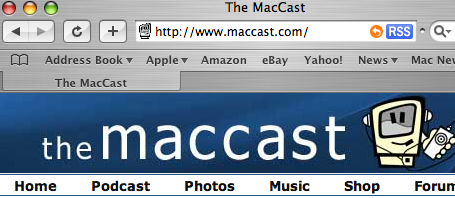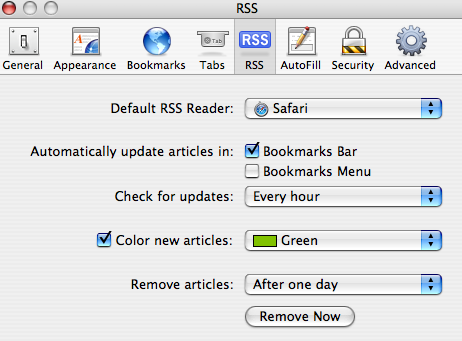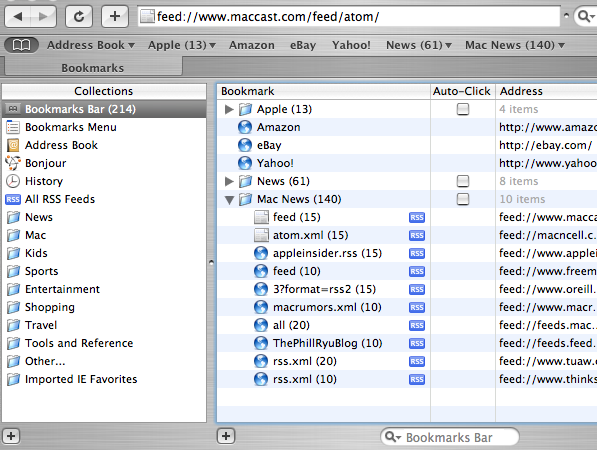 You know all about surfing the web. You’re a power-surfer! You keep in touch with your favorite websites every day. You open links in new background tabs to maximize your time and screen real estate. But do you know about RSS? This post is a quick glimpse at how you can keep up with your favorite websites far more efficiently, all within Mac OS X’s built in browser, Safari 2.0.
You know all about surfing the web. You’re a power-surfer! You keep in touch with your favorite websites every day. You open links in new background tabs to maximize your time and screen real estate. But do you know about RSS? This post is a quick glimpse at how you can keep up with your favorite websites far more efficiently, all within Mac OS X’s built in browser, Safari 2.0.
What is RSS?
Depending on who you talk to, RSS can stand for “Rich Site Summary” or “Really Simple Syndication,” and I think both help to describe what RSS does—respectively from two different perspectives: readers and publishers.
You might think of it as a ticker-tape of the latest headlines and summaries from a specific source, or even groups of sources. RSS is simply a feed of published information, formatted in a way that web-browser-like applications called “news aggregators” or “RSS readers” can understand. Users subscribe to RSS feeds in these news aggregators, and periodically, the aggregator will go out and check for any new updates, to find the latest news from each subscribed feed.
RSS feeds can generally encapsulate any information a web browser can handle. Bloggers use RSS feeds to syndicate their latest blog posts. If you became a fan of the MacCast podcast before reading this blog, you may have been using RSS without even knowing it—as the MacCast podcasts are delivered to your iTunes (or other aggregator) via RSS feeds.
Give It a Try
So, maybe you’ve heard of RSS but were shy to start using them, or just plain didn’t know how. Don’t be, it’s as easy as saving a bookmark. Let’s give it a try.

Maybe you’re reading this post from Safari. That’s great, because Apple has done a great job of easily allowing users who are new to RSS to get their feet wet. Assuming you’re running Mac OS X 10.4 Tiger, you’re at least using Safari 2.0, which has an RSS aggregator built in. From this post, look up at the right corner of the address bar, and you should see a blue button with “RSS” written in it. Before you click it, remember, to get back to this post, just click the back button or click on the “RSS” again. Okay, click it (but please come back for the rest of the story)!


By doing so, Safari transforms from its regular webpage view into an RSS reader. Down drops a summary view of the MacCast blog posts. At the top in the blue bar, on the left you should see the name of the RSS feed, and on the right how many posts are listed. On the right side you can search within the RSS feed’s articles, shorten or lengthen how much of each post is displayed, sort the posts in a number of ways (I’d recommend clicking on “New” instead of the default “Date”), quickly skip to recent articles, see the source of the RSS feed(s) is/are being displayed (more on that later), and some options for sending the RSS feed to someone else, or adding it as a bookmark. Remember, anytime you come across a webpage with that RSS button, that means the page has an RSS feed and you can view the page in the Feed view.
Fine Tuning
That’s all fine and good, but really, surfing to pages just to view them as aggregated posts isn’t what RSS is all about. Let’s look at the Safari Preferences (in the Safari menu or using “Cmd-,”) and click the RSS icon to dig deeper into the options.

First off, for now, we’ll keep Safari as your default RSS reader. The next option talks about which RSS feeds you want updated often—for beginners, lets check the Bookmarks Bar, and check for updates every hour. If you wish, you can pick a color for newly updated feed posts, which should change after you’ve viewed them. Lastly, you can pick a time when the posts expire and drop out of your long list of posts. Personally, I prefer a shorter amount of time—posts tend to add up and can make a little browsing a bit sluggish. You can always “flush” them all by clicking the “remove all” button.
Groups of Feeds
Just like you might have groups of bookmarks in Safari, RSS feeds are very useful when you group them in folders. The most useful is creating folders in your Bookmarks Bar, which lets you see at a glance if any number of feeds have been updated and how many posts are in each folder.
First, lets create a folder in your Bookmarks Bar by clicking on the little Bookmarks icon in leftmost part of Safari’s Bookmarks Bar. This shows all your bookmarks. In the Collections column, select Bookmarks Bar, and then click the little “+” button at the bottom of the right pane to add a folder. You might name it “Mac News”, because in this example we’re going to populate it with some Mac related RSS feeds. Click the Bookmarks icon again to go back to the regular webbrowser. You should now see the Mac News folder in your Bookmarks Bar, with a little drop-down arrow that will eventually list your feeds.

You can add new feeds to this folder in the same way you add bookmarks to a folder. To get things going, here are a list of feeds I currently have in my Mac News Folder:
feed://www.maccast.com/feed/
feed://macncell.com/index_html/atom.xml
feed://www.appleinsider.com/appleinsider.rss
feed://www.freemacblog.com/feed/
feed://www.oreillynet.com/pub/feed/3?format=rss2
feed://www.macrumors.com/macrumors.xml
feed://feeds.macworld.com/macworld/all
feed://feeds.feedburner.com/ThePhillRyuBlog
feed://www.tuaw.com/rss.xml
feed://www.thinksecret.com/rss.xml
Note: If you want to add some or all of these to your Mac News folder, highlight all the text above with your cursor, then click and drag the highlighted text onto your Mac News folder. You should see the little “green plus ball”, then just let go and all the feeds should be in there. Don’t worry about what their names are—that will fill in after the first time Safari updates them.
To see all the feeds aggregated on one screen, click on the Mac News folder and select “View All RSS Articles.” Depending on which setting you selected in preferences, you should start having new updates in about an hour.
Feed Me
Now that you know how to add feeds, you might start wanting to check your regularly viewed websites for their feeds. As noted above, feeds are a great way to keep up with blogs and podcasts (if you don’t like iTunes).
Of course, one feed you should subscribe to right off the bat is the MacCast blog
One of my favorite applications of RSS feeds is Craigslist. Any search you conduct in Craigslist can be saved as an RSS feed. Maybe, like me, you’re looking for a vintage BMW 2002 from the ’70s. If you live in Washington, DC like me, you might subscribe to this feed which was simply generated by a search on Craigslist, and whenever a car that fits your query is posted, you’ll know about it—and much faster than someone who’s just casually searching. I think I just ruined my chances of finding a 2002 around here now. Oops!
There are tons of applications for RSS feeds. Do you have a good one or seventeen? If so, leave a comment and let us all know.





For anyone into Cosmology:
feed://arxiv.org/rss/
feed://arxiv.org/rss/hep-ex
feed://arxiv.org/rss/hep-th
What is the difference between these feeds?
feed://www.maccast.com/feed/
feed://www.macast.com/feed/atom/
I was having some delays (up to 6-8 hours) in getting the feed from the atom feed, and Adam suggested using the first one, without the atom.
Thanks,
Problem with RSS Feed in WordPress.
I have a subdomain that I installed wordpress for another blog site, but the subdomain site's rss feed points to my parent site.
Can anyone come up with any suggestions?